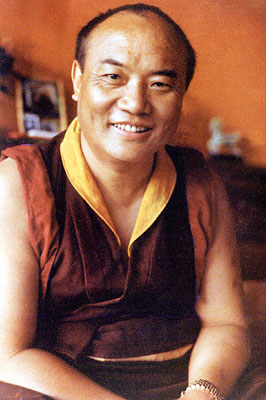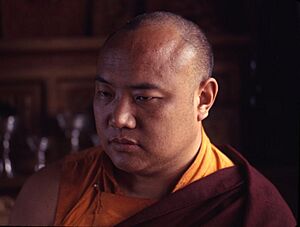Rangjung Rigpe Dorje, 16th Karmapa facts for kids
Quick facts for kids Rangjung Rigpe Dorje |
|
|---|---|
 |
|
| Religion | Tibetan Buddhism |
| School | Karma Kagyu |
| Other names | His Holiness Rangjung Rigpei Dorje |
| Personal | |
| Born | August 14, 1924 Denkhok, Derge, Kham, Tibet |
| Died | November 5, 1981 (aged 57) Zion, Illinois, United States |
| Senior posting | |
| Title | 16th Gyalwa Karmapa |
| Predecessor | Khakyab Dorje |
| Religious career | |
| Reincarnation | Gyalwa Karmapa |
Rangjung Rigpe Dorje (Tibetan: རང་འབྱུང་རིག་པའི་རྡོ་རྗེ་, Wylie: Rang 'byung rig pa'i rdo rje; August 14, 1924 – November 5, 1981) was a very important spiritual leader. He was the 16th Gyalwa Karmapa, a main leader of the Karma Kagyu branch of Tibetan Buddhism. The Karmapas are known as "living Buddhas." Their arrival was even predicted by the Buddha himself! The 16th Karmapa helped bring Vajrayana Buddhism to places like Europe and North America. This happened after China took over Tibet. People called him "King of the Yogis." Many books and films have been made about him.
Contents
The Life of Rangjung Rigpe Dorje
His Early Life
Birth and Childhood
The 16th Karmapa was born in a place called Denkhok. This was in Eastern Tibet, near the Yangtze River. The Karmapa before him, Khakhyab Dorje, left a special letter. This letter described how to find his next life. An attendant of the Karmapa had this letter. It perfectly matched what another important teacher, the 11th Tai Situpa, was already doing. He was looking for the 16th Karmapa.
Learning and Special Ceremonies
Young Rangjung Rigpe Dorje was taken to Palpung Monastery. There, the 11th Tai Situpa taught him many things. He also took special vows. Other teachers taught him about different Buddhist ideas. He learned about Mahamudra and the Six Yogas of Naropa. He saw the 11th Tai Situpa and the 2nd Jamgön Kongtrül as his main teachers.
When he was seven, he performed his first Black Crown ceremony. This is a very special event. At age thirteen, he had his hair cut by the 13th Dalai Lama.
Becoming a Great Teacher
Deep Studies and Important Lessons
During his studies, he learned all the teachings of the Kagyu school. He also learned from the Sakya Trizin for many years. In the early 1940s, he went into a quiet retreat. In 1947, he went on a trip to India. He went again in 1956 with the 14th Dalai Lama.
Rangjung Rigpe Dorje also studied with the 10th Mindrolling Trichen. This teacher was from the Nyingma school. His education finished with a special teaching from the Gelugpa school. This meant Rangjung Rigpe Dorje had learned all the main teachings. He knew the most important lessons from all the major Tibetan Buddhist schools.
Traveling and Sharing Knowledge
The 16th Karmapa continued the work of the Karmapas before him. He traveled and taught all over Tibet, Bhutan, Nepal, Sikkim, India, and parts of China. He could also find the new lives of other important teachers. He did this without needing to meditate.
Escape from Tibet
Predictions of Change
Before China took over Tibet, the Karmapa made some predictions. He said that Tibetan people would need to be ready to escape to India. In 1940, when he was 16, he wrote a poem. This poem predicted that Tibet would be taken over:
Our people shall not stay here. We will go to India.
The cuckoo bird called by the host of spring knows where to go when seeds mature in autumn's bloom. I am not thinking of going anywhere else but to eastern India.
Leaving His Homeland
In 1950, China began to change Tibet. The Karmapa, the Dalai Lama, and other leaders went to Beijing. They tried to make a deal. This worked for a while. But in 1959, the Chinese government wanted to change land ownership. This would hurt the independent monasteries. Conflicts with the spiritual leaders grew.
In February 1959, the Karmapa left Tsurphu Monastery. He took 160 students with him. They escaped to Bhutan. They also took many sacred treasures and relics.
Building a New Home
The King of Sikkim, Tashi Namgyal, offered the Karmapa a place. It was where the 9th Karmapa had built a monastery long ago. It was in ruins. Here, the 16th Karmapa built his new main home. It was called Rumtek Monastery. It officially opened in 1966. The old Tsurphu Monastery in Tibet still exists. But the Chinese government limits how many monks can live there.
Sharing Buddhism with the World
Looking to the West
In the early 1970s, the Karmapa made another prediction. He said Tibet would struggle to be free. Even if it did, refugees might not return. He also thought Rumtek might not always be safe. But he believed the Western world would welcome Buddhism. So, he sent a teacher named Lama Gendün to Europe.
First World Tour
In 1974, with help from Freda Bedi, he started his first world tour. On September 15, he left Rumtek with many teachers and monks. He was welcomed in London on September 17. He traveled to Europe, Canada, and the United States. In the U.S., he was welcomed by Chögyam Trungpa. In October 1974, he visited the Hopi reservation in Arizona. He set up a main center in France called Dhagpo Kagyu Ling. He also performed several Black Crown ceremonies. He even met Pope Paul VI.
More Travels and Teachings
In 1976-77, he went on a longer tour. He gave many teachings. He visited almost every major city in Europe. In May 1980, the Karmapa visited the West again. He gave talks and ceremonies in London, New York, San Francisco, and other cities.
The 16th Karmapa helped bring Tibetan Buddhism to the West. He created Dharma centers and monasteries around the world. This helped protect and spread Buddha's teachings. He also became the first official head of the Kagyu School. This was part of a plan by the Tibetan government-in-exile.
Amazing Stories
There are several stories about special things the 16th Karmapa did. These are often called miracles. Many Buddhist masters before him also had such stories.
Childhood Insights
When the Karmapa was a child, his identity was kept secret. But villagers noticed good signs when he was born. They came to him for blessings. As a child, the Karmapa seemed to know things before they happened. For example, if farmers lost an animal, he knew where it was.
Special Birds
The Karmapa loved birds. It is said that he would bless them when they died. Instead of falling over, the birds would stay stiff and upright for days. People believed the birds were in a deep state of meditation. This was called "liberation through contact."
Helping the Hopi Tribe
In 1974, the Karmapa visited the Hopi tribe in New Mexico. They asked him to help their land, which was very dry. He performed a ceremony. After that, a lot of rain fell. It was the first rain in 75 days! That evening, Hopi and Navajo people received a special blessing.
His Passing
In 1980-81, the Karmapa began his last world tour. He gave teachings and interviews. He visited Southeast Asia, Greece, Great Britain, Canada, and the United States. Rangjung Rigpei Dorjé passed away on November 5, 1981. He was in a hospital in Zion, Illinois, in the United States. Doctors and nurses were amazed by his kindness. He seemed more worried about them than himself.
According to Buddhist sources, one doctor was surprised. The Karmapa did not want pain medicine. He also showed no signs of the deep pain that most patients in his condition feel. When he passed away, his body was left in the hospital for three days. This was against hospital rules but allowed by Illinois. It followed Tibetan tradition.
His body was later cremated at Rumtek. This also followed Tibetan tradition.
His Lasting Impact
Like the Karmapas before him, he was mainly a spiritual leader. He did not get involved in politics. Instead, he worked to keep Tibet's spiritual traditions alive. In this way, he helped preserve Tibet's unique culture and identity.
Tibetan Buddhists believe that Rangjung Rigpe Dorje, like all Karmapas, was a special enlightened being.




